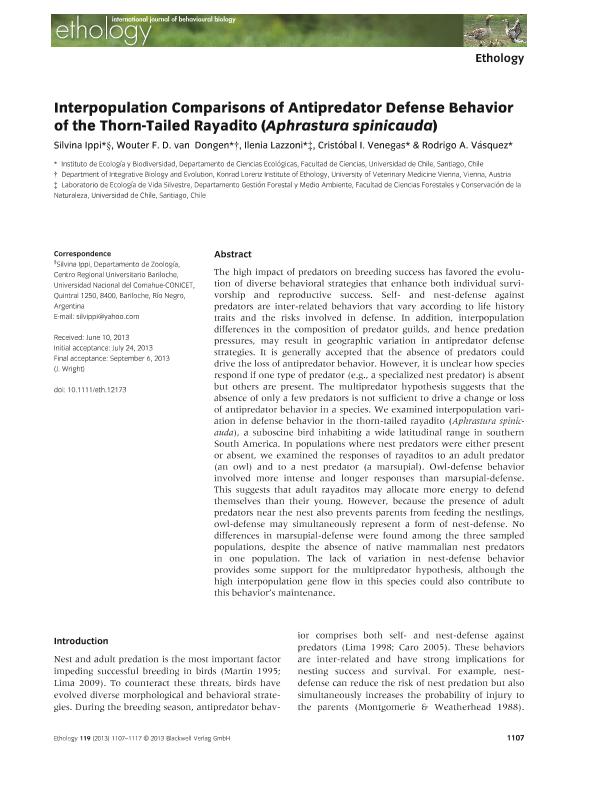Artículo
Interpopulation Comparisons of Antipredator Defense Behavior of the Thorn-Tailed Rayadito (Aphrastura spinicauda)
Ippi, Silvina Graciela ; van Dongen, Wouter F. D.; Lazzoni, Ilenia; Venegas, Cristobal I.; Vásquez, Rodrigo A.
; van Dongen, Wouter F. D.; Lazzoni, Ilenia; Venegas, Cristobal I.; Vásquez, Rodrigo A.
 ; van Dongen, Wouter F. D.; Lazzoni, Ilenia; Venegas, Cristobal I.; Vásquez, Rodrigo A.
; van Dongen, Wouter F. D.; Lazzoni, Ilenia; Venegas, Cristobal I.; Vásquez, Rodrigo A.
Fecha de publicación:
12/2013
Editorial:
Wiley
Revista:
Ethology
ISSN:
0179-1613
Idioma:
Inglés
Tipo de recurso:
Artículo publicado
Clasificación temática:
Resumen
The high impact of predators on breeding success has favored the evolution of diverse behavioral strategies that enhance both individual survivorship and reproductive success. Self- and nest-defense against predators are inter-related behaviors that vary according to life history traits and the risks involved in defense. In addition, interpopulation differences in the composition of predator guilds, and hence predation pressures, may result in geographic variation in antipredator defense strategies. It is generally accepted that the absence of predators could drive the loss of antipredator behavior. However, it is unclear how species respond if one type of predator (e.g., a specialized nest predator) is absent but others are present. The multipredator hypothesis suggests that the absence of only a few predators is not sufficient to drive a change or loss of antipredator behavior in a species. We examined interpopulation variation in defense behavior in the thorn-tailed rayadito (Aphrastura spinicauda), a suboscine bird inhabiting a wide latitudinal range in southern South America. In populations where nest predators were either present or absent, we examined the responses of rayaditos to an adult predator (an owl) and to a nest predator (a marsupial). Owl-defense behavior involved more intense and longer responses than marsupial-defense. This suggests that adult rayaditos may allocate more energy to defend themselves than their young. However, because the presence of adult predators near the nest also prevents parents from feeding the nestlings, owl-defense may simultaneously represent a form of nest-defense. No differences in marsupial-defense were found among the three sampled populations, despite the absence of native mammalian nest predators in one population. The lack of variation in nest-defense behavior provides some support for the multipredator hypothesis, although the high interpopulation gene flow in this species could also contribute to this behavior’s maintenance.
Archivos asociados
Licencia
Identificadores
Colecciones
Articulos(CCT - PATAGONIA NORTE)
Articulos de CTRO.CIENTIFICO TECNOL.CONICET - PATAGONIA NORTE
Articulos de CTRO.CIENTIFICO TECNOL.CONICET - PATAGONIA NORTE
Citación
Ippi, Silvina Graciela; van Dongen, Wouter F. D.; Lazzoni, Ilenia; Venegas, Cristobal I.; Vásquez, Rodrigo A.; Interpopulation Comparisons of Antipredator Defense Behavior of the Thorn-Tailed Rayadito (Aphrastura spinicauda); Wiley; Ethology; 119; 2; 12-2013; 1107-1117
Compartir
Altmétricas



